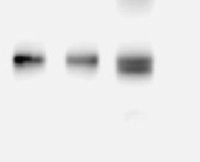1

Anti-PIP (PIP1;1, PIP1;2, PIP1;3, PIP1;4, PIP1;5) | Aquaporins
AS09 487 | Clonality: Polyclonal | Host: Rabbit | Reactivity: A. thaliana, J. curcas, P. nigra, P. trichocarpa, R. sativus
- Product Info
-
Immunogen: KLH-conjugated synthetic peptide conserved in Arabidopsis thaliana: PIP1;1 UniProt: P61837,At3g61430 PIP1;2 UniProt: Q06611,TAIR: At2g45960 PIP1;3 UniProt: Q08733,TAIR: At1g01620 , PIP1;4 UniProt: Q39196,TAIR: At4g00430, PIP1;5 UniProt: Q8LAA6 TAIR:At4g23400
. The peptide is located at N-terminal.Host: Rabbit Clonality: Polyclonal Purity: Immunogen affinity purified serum in PBS pH 7.4. Format: Lyophilized Quantity: 50 µg Reconstitution: For reconstitution add 50 µl of sterile water Storage: Store lyophilized/reconstituted at -20°C; once reconstituted make aliquots to avoid repeated freeze-thaw cycles. Please remember to spin the tubes briefly prior to opening them to avoid any losses that might occur from material adhering to the cap or sides of the tube. Tested applications: Immunofluorescence (IF), Western blot (WB) Recommended dilution: 1: 150 (IF), 1 : 1000 (WB) Expected | apparent MW: 30.68 | 28 kDa - Reactivity
-
Confirmed reactivity: Arabidopsis thaliana, Brassica sp., Jatropha curcas L. cv. Biji Jarak , Mesembryantheum crystallinum, Populus nigra, Populus trichocarpa, Raphanus sativus, Setaria viridis, Thellungiella salsuginea
Predicted reactivity: Brassica sp., Glycine max, Hordeum vulgare, Juglans regia, Medicago truncatula, Nicotiana tabacum, Oryza sativa, Populus tremula, Triticum aestivum, Vicia faba
Species of your interest not listed? Contact usNot reactive in: Fragaria sp., Spinacia oleracea - Application Examples
-
Application information 
10 µg of Arabidopsis thaliana tonoplast fraction (1), Thellungiella salsuginea tonoplast fraction (2), Mesembryanthemum crystallinum tonoplast fraction (3), Nicotiana tabacum tonoplast fraction (4), Arabidopsis thaliana plasma membrane fraction (5), Thellungiella salsuginea plasma membrane fraction (6), Mesembryanthemum crystallinum plasma membrane fraction (7), Arabidopsis halleri microsome fraction (8), Brassica sp. microsomal fraction (9) were extracted with Protein Extraction Buffer PEB (AS08 300). Samples were diluted with 1X sample buffer (NuPAGE LDS sample buffer (Invitrogen) supplemented with 50 mM DTT and heat at 70°C for 5 min and keept on ice before loading. Protein samples were separated on 4-12% Bolt Plus gels, LDS-PAGE and blotted for 70 minutes to PVDF using tank transfer. Blots were blocked immediately following transfer in 2% blocking reagent or 5% non-fat milk dissolved in 20 mM Tris, 137 mM sodium chloride pH 7.6 with 0.1% (v/v) Tween-20 (TBS-T) for 1h at room temperature with agitation. Blots were incubated in the primary antibody at a dilution of 1: 10 000 (in blocking reagent) for 1h at room temperature with agitation. The antibody solution was decanted and the blot was rinsed briefly twice, and then washed 1x15 min and 3x5 min with TBS-T at room temperature with agitation. Blots were incubated in secondary antibody (anti-rabbit IgG horse radish peroxidase conjugated, recommended secondary antibody AS09 602,Agrisera) diluted to 1:25 000 in blocking reagent for 1h at room temperature with agitation. The blots were washed as above. The blot was developed for 5 min with chemiluminescence reagent according to manufacture instructions. Images of the blots were obtained using a CCD imager (VersaDoc MP 4000) and Quantity One software (Bio-Rad). Exposure time was 30 seconds.
The background at the top of the membrane can be optimized.
Courtesy of Dr. Rosario Vera, UNAM, Mexico - Additional Information
-
Additional information: Antibodies will detect target protein in a few µg of a crude preparation loaded per well, If purified preparations of vacuolar and plasma membranes are used, one µg load per well should be sufficient Additional information (application): Protein or membrane sample should be treated at 70°C for 10 min before loading on the gel.
- Background
-
Background: PIPs proteins are aquaporins which facilitate the transport of water and small neutral molecules across the cell membrane. Alternative names: PIP1-1, PIP1-2, PIP1-3, plasma membrane intrinsic protein 1a, 1b, 1c, PIP1a, PIP1b, PIP1c, plasma membrane aquaporin-1, transmembrane protein A, TMP-A, AthH2, transmembrane protein B, TMP-B.
- Product Citations
-
Selected references: Takáč et al. (2024). Actin cytoskeleton and plasma membrane aquaporins are involved in different drought response of Arabidopsis rhd2 and der1 root hair mutants. Plant Physiology and Biochemistry Available online 19 September 2024, 109137.
Chen et al. (2022) Elucidating the role of SWEET13 in phloem loading of the C4 grass Setaria viridis. Plant J. 2022 Feb;109(3):615-632. doi: 10.1111/tpj.15581. Epub 2021 Dec 12. PMID: 34780111.
Jang et al. (2013). Twoaquaporins of Jatropha are regulated differentially during drought stress and subsequent recovery. J Plant Physiol. March 25.
Lopez et al. (2013). Aquaporins And Leaf Hydraulics, Poplar Sheds New Light. Plant Cell Physiol. Sep 20. - Protocols
-
Agrisera Western Blot protocol and video tutorials
Protocols to work with plant and algal protein extracts
Oxygenic photosynthesis poster by prof. Govindjee and Dr. Shevela
Z-scheme of photosynthetic electron transport by prof. Govindjee and Dr. Björn and Dr. ShevelaMethod for isolation of plant plasma membranes
.jpg)
Courtesy of Dr. Masayoshi Maeshima, Laboratory of Cell Dynamics, Graduate School of Bioagricultural Sciences Nagoya University Nagoya, Japan
- Reviews:
-
This product doesn't have any reviews.


